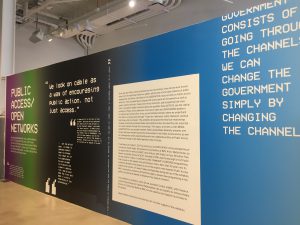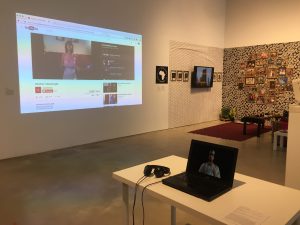This week, I visited BRIC Art / Media House and the Public Access / Open Networks Exhibition it was holding. BRIC isn’t necessarily known to a lot of students because of its small title, but the exhibition was beyond amazing. It was very much “experimental” and I wished the whole class could have been there to see and experience the displays they had to offer. Plus, it was free. (This exhibition is still going on through May 7). The exhibition was on Public Access / Open Networks. I’m not going to lie. Initially, I was so confused to what this exhibition was all about. All I knew was that it had to do with more contemporary art.
On thing I realized was that because the BRIC Art / Media House was such a small area for multiple events, it really emphasized one or two exhibitions at a time. The main one being, Public Access / Open Networks. They utilized the whole space including the walls. Let me tell you, it was definitely aesthetically pleasing and beautifully set. Also, I went at a time when it was empty so I literally went all over the place several times.
The exhibition was all about the history of Public Access Television (1970s) as well as using technology in media to raise movements and encourage activists to have a voice. Because in the 1970s, cable started to open opportunities for this “alternate television” of free speech and free fo rm art. Many artists rose in this era and they are recognized and remembered today for their sense of bravery to pull through with such new and unique styles of expression through art. Just like the quote in the exhibition display, “we look on cable as a way of encouraging public action, not just access”. This change in technology and media opened doors to take action and make a move, not just know that there is access and not do anything. Another quote that hit me was, “[the artist] must seek the truth and make it visible regardless of the consequences”. These people were desperate to create content that will get the world stirring and hungry for freedom. Freedom to be whoever they want to be. Queer, gay, happy, sad, expressive, angry, etc.. These artists desired to be open and out there.
rm art. Many artists rose in this era and they are recognized and remembered today for their sense of bravery to pull through with such new and unique styles of expression through art. Just like the quote in the exhibition display, “we look on cable as a way of encouraging public action, not just access”. This change in technology and media opened doors to take action and make a move, not just know that there is access and not do anything. Another quote that hit me was, “[the artist] must seek the truth and make it visible regardless of the consequences”. These people were desperate to create content that will get the world stirring and hungry for freedom. Freedom to be whoever they want to be. Queer, gay, happy, sad, expressive, angry, etc.. These artists desired to be open and out there. 
There were many things that fascinated me. One was the display on Ann Hirsch. She is a video artist who “deconstructs female sexuality and the male gaze to explore how technology and social media shape perceptions of gender and identity”. She used YouTube and created this character where she would try to portray herself as a who who is both sexual and human. This was provoking and interesting because many the Internet rarely mentioned this combination of whether woman can be both sexual and human. It definitely had a feminist undertone, which is very much more expressive and accepted today.
One interesting one was Static.  It really didn’t have much description except that it loops every two minutes, but I liked this display. It was literally a static screen, but I could watch it for a long time without being bored because even though it can be “just static”, it also seemed so expressive, chaotic, and noisy. Almost as if it was trying to tell me something.
It really didn’t have much description except that it loops every two minutes, but I liked this display. It was literally a static screen, but I could watch it for a long time without being bored because even though it can be “just static”, it also seemed so expressive, chaotic, and noisy. Almost as if it was trying to tell me something.
Lastly, I enjoyed a video display of Nam June Paik’s Good Morning Mr. Orwell (1984). I loved the crazy editing as well as the use of colors. No to mention, the way the sound flowed beautifully with the visuals was beautiful. Paik’s videos “explore the intersection of the art world, pop culture, media, philosophy, and technology. Good Morning Mr. Orwell (1984) was in particularly so amazing because it showcased “his vision for this globalized new media in a live international satellite installation”. He desired international potential in television, which is very common and well used today. (Sadly, I forgot to take a picture of this.)
One last quote is: “Public Access is the mother of all social media, the original uncurated social art”. While I was watching these different type of videos, hearing so many voices, and reading so many hopes and dreams, I realized that Public Access really began this journey of expression through Media. It’s because of those artists who initiated and started their artwork… that we are here today, strong and bold, bonded and united, when social issues and movements are created for the better of today.
*If ya’ll are interested in the history of Public Access and the experimental pieces artists used to express their voices, GO TO THE EXHIBITION!!!